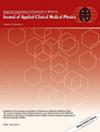Implementation of intelligent All-in-one technology in rectal cancer radiotherapy: A retrospective study on automation efficiency and safety
Abstract
Purpose
This study aims to assess percentage of automated AIO plans that met clinical treatment standards of radiotherapy plans generated by the fully automated All-in-one (AIO) process.
Methods
The study involved 117 rectal cancer patients who underwent AIO treatment. Fully automated regions of interest (ROI) and treatment plans were developed without manual intervention, comparing them to manually generated plans used in clinical practice. Geometric and dosimetric metrics were collected from both automated and manual plans. The relationship between the geometric and dosimetric metrics of the planning target volume (PTV) was evaluated using Spearman correlation analysis. The interquartile range (IQR) method was applied to determine the percentage of automated plans meeting clinical requirements. Additionally, dosimetric metrics for organs at risk (OAR) were compared between automated and manual plans using paired t-tests. The reasons for dose discrepancies were examined based on target volume.
Results
Spearman correlation analysis showed a moderate correlation between geometric metrics and the conformity index (△CI) in dosimetric metrics. The correlation coefficients were as follows: Hausdorff distance (HD, |ρ| = 0.458, p < 0.01), Mean deviation area (MDA, |ρ| = 0.565, p < 0.01), Dice similarity coefficient (DSC, |ρ| = 0.631, p < 0.01), and Jaccard index (JI, |ρ| = 0.632, p < 0.01). Statistical analysis revealed that the mean doses to the bladder and bilateral femoral heads were significantly lower in automated plans compared to manual ones (p < 0.01). This difference is likely due to variations in ROI delineation between automated and manual methods. The IQR method showed that 81.2% of automated AIO plans met clinical requirements without manual intervention.
Conclusion
In routine clinical practice, approximately 81.2% of automated AIO plans met clinical requirements without requiring manual intervention.




 求助内容:
求助内容: 应助结果提醒方式:
应助结果提醒方式:


